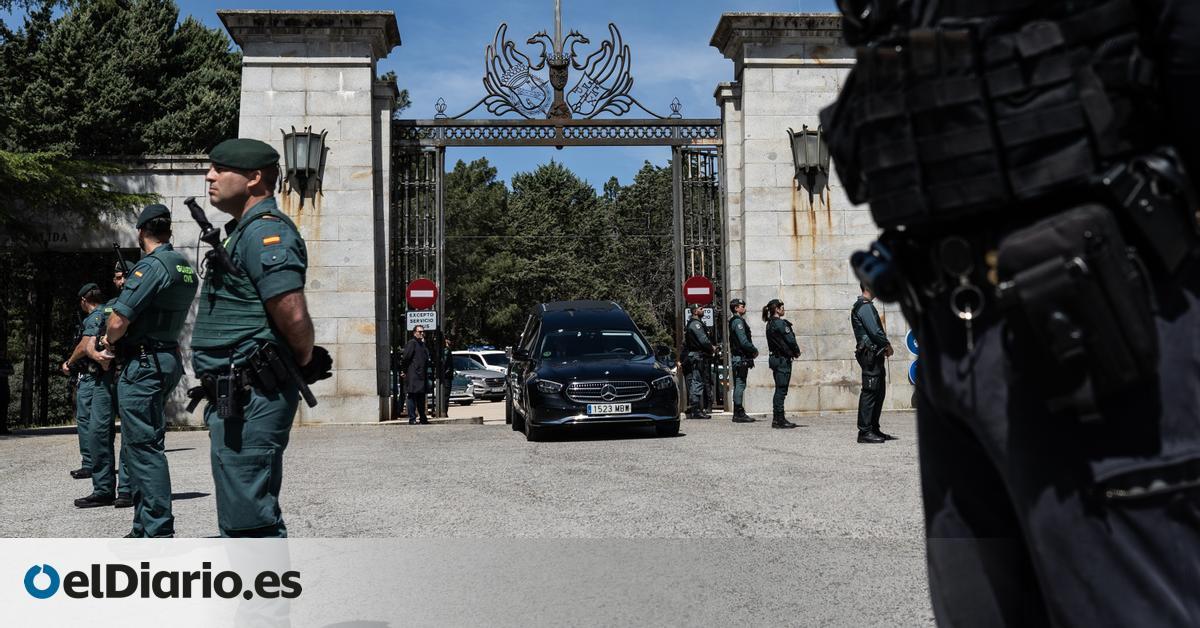
64 years after the inauguration of the Valley of the Fallen —now called Cuelgamuros—, the remains of the founder of the Falange, José Antonio Primo de Rivera, have left the temple to comply with the Democratic Memory Law approved in 2022. The exhumation process It has been held behind closed doors since early this Monday morning. Around 7.40 two hearses and a funeral home van entered, as well as some family vehicles. Five hours later, around 1:00 p.m., the funeral procession with the remains of Primo de Rivera headed towards the San Isidro cemetery, while a dozen people fired him with banners and shouts of “José Antonio present.”
The exhumation of the Falangist comes four years after the corpse of Francisco Franco was exhumed from the same Valley in October 2019 and half a year after the mortal remains of Gonzalo Queipo de Llanocoup general, were likewise exhumed from the Macarena Basilica.
Primo de Rivera was tried by the Republic for uprising, shot in 1936 and buried in a common grave. At the end of the war, he was transferred to the Monastery of El Escorial and in 1959 to its current location by decision of the dictator. In October of last year, the Democratic Memory Law entered into force, which in its article 54.4 establishes that only the remains of people who died in the War may lie in the Valley, but in no case occupy a “preeminent place in the enclosure,” as This is the case of the founder of the Falange, buried at the foot of the main altar of the basilica. This article is complemented by 38.2, which rejects that the remains of those responsible for the military coup may be in those “preeminent places.”
Discreetly and with relatives
Although there was the legal possibility of keeping his remains in one of the crypts attached to the temple, thus removing them from their prominent location, the family chose to take them to a Catholic cemetery, that of San Isidro in Madrid, as he himself had indicated in his will. . Since last October, with the entry into force of the law, the Valley has become a civil cemetery. The extraction of the coffin has been consummated discreetly, with the temple closed to the public, only in the presence of the relatives and the workers in charge of raising the great slab that covers his grave and without journalists, in an operation that will comply with one of the sections of the Democratic Memory Law of 2022. The prior of the Benedictine abbey, the controversial Santiago Cantera, has prayed a response before the coffin leaves the mausoleum towards the cemetery. Once there, after cremation, the remains will be deposited along with those of other relatives, such as her brothers Miguel Primo de Rivera and Sáenz de Heredia, who was a minister with Franco, and Pilar Primo de Rivera, founder of the Women’s Section.
The cemetery began small reconditioning works on Friday to prepare for the arrival. Specifically, those in charge of maintenance have spread sand around four of the six tombs that the Primo de Rivera saga maintains in the cemetery, tidying up their surroundings.
The entire process has been undertaken in agreement with the family and has been exempt from the enormous media expectation and political controversy that in 2019 accompanied the exhumation of the dictator Francisco Franco, buried next to Primo de Rivera since 1975.
Unlike what happened between 2018 and 2019 with the exhumation of Franco, paralyzed by the Supreme Court for months at the request of the family and with strong public opposition from the dictator’s descendants, from the beginning the relatives of Primo de Rivera have asked that this process be done “within privacy” and that it not become a “public exhibition prone to confrontations of any kind between Spaniards.” The descendants anticipated any government action for the relocation and, as soon as the regulation was approved, they communicated their intention to exhume it, both to the prior of Cuelgamuros and to the Community of Madrid, at the same time that they requested the works permit from the City Council of San Lorenzo de The Escorial.
Falangist groups against the exhumation
Despite the fact that the family has asked for the exhumation to be carried out discreetly, hundreds of ultra-rightists have received the remains in the San Isidro cemetery amid songs and fascist greetings. The Police defined a safety distance to separate the Falangists from the cemetery. However, some protesters jumped over the cordon and confronted the police while the rest cheered them on shouting “¡Arriba España!”, “José Antonio” and singing the Face to sun.
Regarding possible sanctions that the Government could apply for the tributes to Primo de Rivera, the Falangist parties are convinced that there is no legal basis to sanction them, since they are paying tribute to a victim of the Civil War, as they argue. The Government has already opened a file on the Falange for various demonstrations that took place on November 20. They point out, however, that the process is halted.
Along these lines, the Francisco Franco National Foundation has described the exhumation of the remains as a “ruinous and civil war action by the Government” and has described its president, Pedro Sánchez, as the “undisputed world champion of infamy” for his action. “miserable”.
More than 8,500 euros
The amount budgeted for the removal of the 3,500-kilo granite tombstone that covers the grave and its replacement with six black marble slabs similar to the one on the floor that surrounds it amounts to 8,630 euros.
This Sunday, the Deputy Secretary General of the PSOE and Minister of Finance, María Jesús Montero, valued the exhumation of the remains of the founder of La Falange, as a gesture of “justice and democratic dignity.” “It is necessary to comply with the dignity of the victims and the democratic memory. In short, comply with the law so that no person who has participated in the coup with prominence, like Primo de Rivera, is in a place where his figure can be exalted ”, she added.
The remains of José Antonio Primo de Rivera have passed through various locations throughout history. In fact, this is the fifth burial for him. The founder of the Falange was first buried in Alicante, first in a common grave and then in a niche. In 1939 his coffin was moved to El Escorial in a procession on foot that lasted ten days until its final destination in the chapel of the kings of the monastery. Twenty years later, in 1959, the remains were moved again, this time to the Cuelgamuros basilica, coinciding with the inauguration of the site ordered to be built by Franco to perpetuate the memory of those who fell “in our glorious crusade” under an enormous cross. of stone of 150 meters.
A right that the victims of Francoism have been requesting for years
The exhumation of Primo de Rivera, only six months after it was requested by the family, takes place while the descendants of those retaliated against during the Civil War and buried in the Valley have been requesting that same right for years.
In what is now called Valle de Cuelgamuros lie the remains of 33,833 people, combatants on both sides of the Civil War, a third unidentified. In this way, Cuelgamuros continues to be the largest mass grave in Spain. There are descendants who want to take care of their relatives; but exhumations have been subjected to numerous obstacles in recent decades, both political and judicial. Last December, the Government finally resumed work to recover the remains of 118 victims claimed by their families, after a stoppage of several months ordered by a court in Madrid.
The spokesman for the Association for the Recovery of Historical Memory, Emilio Silva, lamented a few days ago in statements to this medium “that there are still thousands of Republican families who are waiting for the exhumation of their relatives” and hope that these identifications are made with “public aid”. “The only reality is that politicians have been exhumed and not the victims,” added lawyer Eduardo Ranz, whose relatives are still in Cuelgamuros.
Source: www.eldiario.es

